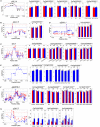New Candidate Genes Affecting Rice Grain Appearance and Milling Quality Detected by Genome-Wide and Gene-Based Association Analyses
- PMID: 28101096
- PMCID: PMC5209347
- DOI: 10.3389/fpls.2016.01998
New Candidate Genes Affecting Rice Grain Appearance and Milling Quality Detected by Genome-Wide and Gene-Based Association Analyses
Abstract
Appearance and milling quality are two crucial properties of rice grains affecting its market acceptability. Understanding the genetic base of rice grain quality could considerably improve the high quality breeding. Here, we carried out an association analysis to identify QTL affecting nine rice grain appearance and milling quality traits using a diverse panel of 258 accessions selected from 3K Rice Genome Project and evaluated in two environments Sanya and Shenzhen. Genome-wide association analyses using 22,488 high quality SNPs identified 72 QTL affecting the nine traits. Combined gene-based association and haplotype analyses plus functional annotation allowed us to shortlist 19 candidate genes for seven important QTL regions affecting the grain quality traits, including two cloned genes (GS3 and TUD), two fine mapped QTL (qGRL7.1 and qPGWC7) and three newly identified QTL (qGL3.4, qGW1.1, and qGW10.2). The most likely candidate gene(s) for each important QTL were also discussed. This research demonstrated the superior power to shortlist candidate genes affecting complex phenotypes by the strategy of combined GWAS, gene-based association and haplotype analyses. The identified candidate genes provided valuable sources for future functional characterization and genetic improvement of rice appearance and milling quality.
Keywords: GWAS; chalkiness; gene-based association analysis; grain shape; milling; rice.
Figures



Similar articles
-
Genome-Wide Association Study of Grain Appearance and Milling Quality in a Worldwide Collection of Indica Rice Germplasm.PLoS One. 2015 Dec 29;10(12):e0145577. doi: 10.1371/journal.pone.0145577. eCollection 2015. PLoS One. 2015. PMID: 26714258 Free PMC article.
-
High-resolution QTL mapping for grain appearance traits and co-localization of chalkiness-associated differentially expressed candidate genes in rice.Rice (N Y). 2016 Dec;9(1):48. doi: 10.1186/s12284-016-0121-6. Epub 2016 Sep 22. Rice (N Y). 2016. PMID: 27659284 Free PMC article.
-
Bin-based genome-wide association studies reveal superior alleles for improvement of appearance quality using a 4-way MAGIC population in rice.J Adv Res. 2020 Aug 11;28:183-194. doi: 10.1016/j.jare.2020.08.001. eCollection 2021 Feb. J Adv Res. 2020. PMID: 33364055 Free PMC article.
-
Genome-wide and gene-based association mapping for rice eating and cooking characteristics and protein content.Sci Rep. 2017 Dec 8;7(1):17203. doi: 10.1038/s41598-017-17347-5. Sci Rep. 2017. PMID: 29222496 Free PMC article.
-
Genetic control of grain appearance quality in rice.Biotechnol Adv. 2022 Nov;60:108014. doi: 10.1016/j.biotechadv.2022.108014. Epub 2022 Jun 28. Biotechnol Adv. 2022. PMID: 35777622 Review.
Cited by
-
Tolerance of Iron-Deficient and -Toxic Soil Conditions in Rice.Plants (Basel). 2019 Jan 28;8(2):31. doi: 10.3390/plants8020031. Plants (Basel). 2019. PMID: 30696039 Free PMC article. Review.
-
Substitution Mapping of Two Closely Linked QTLs on Chromosome 8 Controlling Grain Chalkiness in Rice.Rice (N Y). 2021 Oct 2;14(1):85. doi: 10.1186/s12284-021-00526-4. Rice (N Y). 2021. PMID: 34601659 Free PMC article.
-
Mapping of qChalk1 controlling grain chalkiness in japonica rice.Mol Biol Rep. 2023 Jul;50(7):5879-5887. doi: 10.1007/s11033-023-08537-8. Epub 2023 May 25. Mol Biol Rep. 2023. PMID: 37231212
-
Genome-Wide Association Study of Rice Grain Shape and Chalkiness in a Worldwide Collection of Xian Accessions.Plants (Basel). 2023 Jan 17;12(3):419. doi: 10.3390/plants12030419. Plants (Basel). 2023. PMID: 36771503 Free PMC article.
-
Genome-wide association mapping and gene expression analysis reveal candidate genes for grain chalkiness in rice.Front Plant Sci. 2023 Apr 14;14:1184276. doi: 10.3389/fpls.2023.1184276. eCollection 2023. Front Plant Sci. 2023. PMID: 37123865 Free PMC article.
References
-
- Bai X., Luo L., Yan W., Kovi M. R., Zhan W., Xing Y. (2010). Genetic dissection of rice grain shape using a recombinant inbred line population derived from two contrasting parents and fine mapping a pleiotropic quantitative trait locus qGL7. BMC Genet. 11:16. 10.1186/1471-2156-11-16 - DOI - PMC - PubMed
-
- Chen H. M., Zhao Z. G., Jiang L., Wan X. Y., Liu L. L., Wu X. J., et al. (2011). Molecular genetic analysis on percentage of grains with chalkiness in rice (Oryza sativa L.). Afr. J. Biotechnol. 10, 6891–6903. 10.5897/AJB11.208 - DOI
LinkOut - more resources
Full Text Sources
Other Literature Sources

